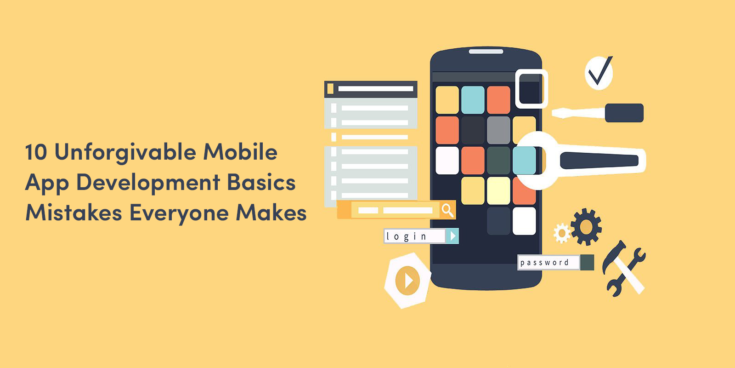With the advancements in technologies and the advent of smartphones, wide-open opportunities have made their way in the mobile app development industry for building novel and innovative mobile applications that can simplify human lives.
While looking at the Statista’s prediction of huge revenue generation by mobile apps in 2020 ($581.9 billion) we cannot ignore the fact that app uninstalls also remain a significant pain point in the fight against churn and need to understand when, why and which users appear to take such a disappointing move.
Worldwide mobile app revenues in 2014 to 2023 (in billion U.S. dollars)
3 out of 10 apps getting uninstalled within 30 days of a download raises our concern towards digging deep on the mobile app development basics which were ignored by those app developers that unexpectedly lead to an increase in the uninstall rate.
From features to design to bug fixes to marketing, creating a welcoming and durable mobile app is no small undertaking. Many developers, entrepreneurs, and beginners might assume that mobile app development is much simpler than it seems but they often find themselves forgetting the crucials that are involved outside the realm of coding.
The arising need today is to understand ways to banish the ignored mistakes and improve the process of overall app creation for a mobile app to stick into a user’s smartphone until it exhausts its lifetime.
So let’s get our attention towards the top mistakes that are made and ignored to be resolved unintentionally that could not let your app to land up in the Uninstalled Apps Category unless you become aware of them and actively work on them.
Top Mobile App Development Basic Mistakes to Avoid to Release your App on the Right Foot
1 Choose to Build for Multiple Platforms
Building mobile applications for multiple platforms is a big decision to make, especially, when you have limited time, resources, and budget.
Even though Android and iOS hold a majority of the market share, developing apps for both these operating systems at once is not a cakewalk if seen from the perspective of practical implementation. There are many who even try to include Microsoft Store in the mix and make the biggest mistake of ending into a playground of confusion which impacts the development spree.
For indie developers, it’s not less than a mistake to try the luck of their app over each available platform when they are low on chances of money as well as time.
A feasible choice is to go for picking up one major platform based on the target audience’s mobile app usage, get the results after its launch and then roll out its version on the other platforms, a few months later after the first release.
[Prefer Reading: “Top Essential App Development Tools for Android [2020]”]
2 Bad Interface & Design Features
Your app’s user interface interacts with the user and builds its first impression that decides its fate and not paying close heed to this essential element of mobile app development may cause you heavy on your overall investments dedicated to developing a mobile application.
“User Interface is the Face of your Mobile App that can either Build or Break User Interaction.”
App stores are deluged with millions of apps performing the same tasks and activities and apparently, today users are too impatient to make a call of accepting or rejecting an app on their mobile devices.
Thus, effective and differential UI/UX designs form the retention key of your mobile apps where each added feature must be useful and the app design must be justified with the app concept.
Bad UI/UX discourages and annoys users and adversely affects user engagement. Checkout some consequences that your high-end app may bestow upon users due to not achieving the benchmark over User Interface:
- Decreases efficiency
- Negative effects on productivity
- Descended user retention rates
- Reduces development costs
- Low returns on investment
3 Creating App Similar to Desktop Apps with a Reflection of its Website Version
Whether experienced or a novice, developers must be dexterous to craft and design a mobile app that distinct itself from its desktop version and must not predict the same look and feel that one can find on its related website.
This is one of those countable mistakes which is recognized by users in one go and becomes the reason for an application’s instant non-acceptance. Creating a small version of the desktop app doesn’t do justice with the creativity of developing it and mobile app programmers must consider it vital from a serious angel.
The major motive of developing an application is to make users identify it with their website with the same functional capabilities (as that of the website) with a unique style, add-on features, design, etc. that levels up their experience of using it as a handy asset.
Undeniably, both app and website can be accessed through e-devices, nevertheless, the functionality must differ based on the individual objectives and user-base.
Developers,
No mobile app must be developed considering it as its desktop or website counterpart. Enhanced mobile app user experience can proportionately boost the business gains likely to be achieved by its desktop app or its website version.
Whether experienced or a novice, mobile app developers Dubai must be dexterous to craft and design a mobile app that distinguishes itself from its desktop version and must not predict the same look and feel that one can find on its related website.
[Prefer Reading: “Top 10 Trends that Define the Future of Mobile Applications in 2020 & Beyond.”]
4 Apps Consuming Too Much Space
A mobile app, as we know is a compact model of its desktop/website version when compared from a few aspects of storage, battery, size dimensions, and many among others.
A mobile app occupying a desirable amount of device memory isn’t a welcoming feature in the public eyes and is a mistake that keeps weight in deserting a mobile application that possesses even everything perfectly and practically.
This could be one of the worst mistakes of all app developers to be ignorant of the app’s size which further lowers its user retention rate. To keep up with this basic need you need to optimize your web assets, break down APK, and do some code obfuscation.
Take a look at a few notable steps to follow:
- Reuse resources
- Support specific densities
- Compress PNG/JPEG files
- Reduce unnecessary codes
- Crunch required file formats
- Minimize resource use from libraries
5 Testing without Contexting
App work cannot be labeled as complete unless it undergoes iterations of testing its features and functionalities.
Some organizations do not possess a dedicated team of testers and analysts who are well versed with product testing, which includes all types of testing. Unfortunately, many developers fail to execute this phase of mobile app development and are in a rush to get their app out of the door.
Testing is a crucial stage where one can discover possibilities of failures, catch unidentified bugs, and can even tighten up the overall design of a mobile app. With the availability of smart devices almost everywhere, it’s paramount to test an app for all platforms and devices to check their compatibility and feasibility index.
So testing must be performed at each magnitude of app development to keep no room for any type of errors that are caught by users and are reviewed publicly, marking a note of app glitches and reporting bugs.
Quality is what the need of the hour, failing to ensure proper testing could fail to highlight the potential bugs and could result in the dropping of the app downloads and ratings.
6 Building Overcrowded Apps with Unnecessary Features
More the features, More the Users– this is where developers make an unknowable mistake.
Adding non-required features at every point of app navigation will make it cumbersome and bulky and would lead to further problems of slow speed, more loading time, etc. that will ultimately affect the scale of user experience.
Yes, businesses must strive to build ‘feature-rich’ apps but must not end up tagging them as ‘feature-excessive’ which would add no value to the end-users and won’t get you any appreciation for all your hefty efforts.
Mobile app programmers must concentrate on adding limited and highly targeted features and functionalities which would add a purpose to your app, making it more preferable by actually serving its objective of being mobile and handy.
7 Ignoring the Importance of MVP
Developing an MVP (Minimum Viable Product) of your mobile application saves it from outbursting and being a disaster in the end.
MVP development allows you to build a dynamic prototype of the idea with minimalist working features that offer a chance to test the product in real-time market conditions and delivers practical results and feedback from real users based on its performance and productivity.
“MVP is an approach that allows the development of the essentials in a project, with bare feature sets. It offers plenty of benefits in the overall process of developing a business idea and helps you harness the potential by minimizing the risks.”
MVP is a worthwhile investment that outputs real-time insights of the mobile app determining its user engagement, understanding the target market and audience, and getting reviews on its further improvements and all that with a little spending.
8 App Marketing Considered Trivial & Done Lately
If you were able to successfully launch your app with verified testing, approved designing, and deployment, what do you think is the perfect time to make it visible to the audience?
Well, marketing is not the developer’s play but there are many developers who consider advertising the app after its perfect launch. This is another misconception that can lead your app to appear last in the race.
Mobile app promotion shouldn’t be started along with the start of the development phase, but it should be started long prior to your app’s release. Early marketing of mobile applications is done with an intent to pique the interest of the users and spread its awareness among the audience.
This way, drumming up the excitement of the masses will help you build a user base that already knows your app and is ready to experiment with it by downloading it on its final launch.
Marketing of a product in this era of cut-throat competition isn’t a cakewalk and requires considerably a lot of legwork and efforts to spread its visibility and make an online presence.
Therefore, once you have the app design nailed and requisite features up and running, run the early campaign of your app that shows its present functionalities and keep on posting valuable content and feed to demonstrate how it’s evolving steadily.
9 Forgetting Monetization & Underestimating the Budget
Mobile app development incurs a huge investment even though it doesn’t seem to be. Thus, before stepping a foot forward make sure you understand and analyze the need for resources and the expenditures related to the overall development.
- Evaluate development hours
- Process overheads
- Estimate the required space
- Calculate marketing cost
- Establish an operations team
Next developers must also incorporate a monetization strategy into their interface and design that will help them deliver a fluid user experience from scratch, eliminating the chances of such problems to appear in the end.
Early on the development stage, you must build up an effective monetization strategy so that your highly designed and created mobile app doesn’t fail to live up to your expectations, keeping intact its monetary value, no matter how renowned it is.
10 Ignored App Reviews and Feedback
“Feedback of the Users id the Voice of the Audience!”
And if you are ignorant at the feedback given by the app operators and users or even delay in banishing the loopholes within the app, you may witness a downfall with its usage and its popularity, and overall growth.
Reviews and feedback (both good and bad) are there to face you up with the areas of improvement and help you to develop robust strategies to expand your user base. Any business that ignores customer reviews is unlikely to make a lasting impression on the mobile app market.
So, if you are looking for top-notch mobile application development services for your business, rely upon NetSet Software Solutions for all kinds of mobile application development requirements. We provide Agile software development teams with flexible hiring models and serve clients across the globe.



